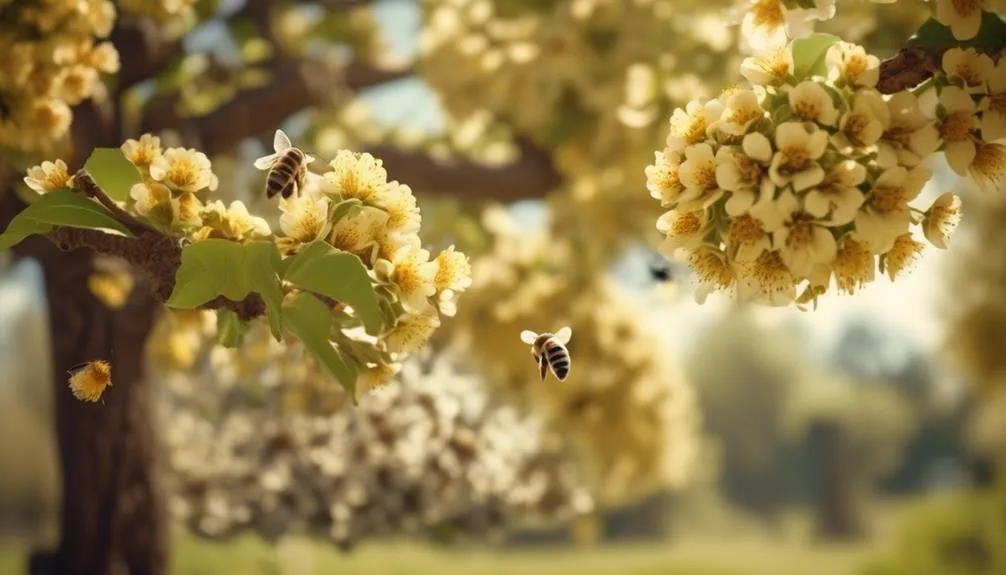Walnut trees rely on cross-pollination for successful reproduction and a good yield. This natural process is essential for their growth.
But have you ever wondered why? Let's explore the reasons behind this and what happens if cross-pollination doesn't occur. Understanding this aspect of walnut tree biology can help us appreciate the intricate ways in which nature works.
Key Takeaways
- Cross-pollination is crucial for successful fertilization and abundant nut production in walnut trees.
- It increases genetic diversity, which is essential for the overall health and resilience of walnut tree populations.
- Environmental factors and the presence of compatible pollinators play a significant role in the efficiency of walnut tree pollination.
- Facilitating cross-pollination through various methods can lead to increased yield, improved harvest quality, and resistance to diseases and pests.
Importance of Cross-Pollination for Walnut Trees
Cross-pollination is essential for walnut trees to ensure the successful fertilization of their flowers, resulting in the production of healthy and abundant nuts. The benefits of cross-pollination are numerous. It leads to increased genetic diversity, which is crucial for the overall health and resilience of walnut tree populations.
Cross-pollination also enhances the quality and quantity of nuts produced, as it facilitates better fertilization and development of the nuts. However, there are challenges associated with cross-pollination. One of the main challenges is ensuring the presence of compatible pollinators within the vicinity of the walnut trees. Additionally, environmental factors such as wind and rain can affect the efficiency of cross-pollination.
Despite these challenges, the benefits of cross-pollination far outweigh the difficulties, making it a vital process for the successful growth and productivity of walnut trees.
Key Factors Affecting Walnut Tree Pollination
To ensure successful walnut tree pollination, it's important to consider key factors that can influence the process.
Factors such as the proximity of compatible walnut tree varieties, the presence of pollinators like bees, and environmental conditions play a crucial role in the pollination process.
The proximity of compatible varieties is essential as it determines the ease with which pollen can be transferred between trees.
Additionally, the presence of pollinators is vital for the transfer of pollen between flowers.
Environmental conditions, including temperature and humidity, can also influence the pollination process and subsequent tree fertility.
Understanding and optimizing these factors can significantly increase the likelihood of successful walnut tree pollination, leading to improved yield and quality of the harvest.
Understanding Walnut Tree Reproduction
Understanding how walnut trees reproduce is essential for maximizing the success of walnut tree pollination and ensuring a bountiful harvest. Walnut trees are monoecious, meaning they have separate male and female flowers on the same tree. This unique reproductive system requires the transfer of pollen from the male flowers to the female flowers for successful fertilization. To achieve this, walnut trees rely on wind or insects for pollination. Understanding pollination is crucial for ensuring that these processes occur effectively. Moreover, walnut trees need genetic diversity for optimal growth and resistance to diseases. Cross-pollination between different walnut tree varieties is essential for maintaining genetic diversity. The table below summarizes the key points for understanding walnut tree reproduction.
| Key Points for Understanding Walnut Tree Reproduction |
|---|
| Walnut trees are monoecious |
| Pollination occurs through wind or insects |
| Genetic diversity is crucial for optimal growth and disease resistance |
| Cross-pollination between varieties is essential for genetic diversity |
Methods for Facilitating Cross-Pollination in Walnut Trees
Facilitating cross-pollination in walnut trees requires strategic planning and thoughtful selection of compatible varieties to ensure successful reproduction and genetic diversity.
There are several methods for facilitating pollination in walnut trees:
- Planting Compatible Varieties: Choose and plant compatible walnut tree varieties in close proximity to encourage cross-pollination.
- Introducing Pollinators: Introduce honeybees or other pollinators to the walnut tree orchard to enhance cross-pollination.
- Timing of Blooms: Select walnut tree varieties with staggered bloom times to extend the pollination window and increase the likelihood of successful cross-pollination.
- Artificial Pollination: Utilize tree breeding techniques such as artificial pollination to directly transfer pollen between compatible walnut tree varieties.
Benefits of Successful Cross-Pollination for Walnut Tree Yield
Successfully cross-pollinated walnut trees can significantly increase yield and improve the quality of the harvest. By ensuring that pollen from one tree fertilizes the flowers of another, walnut trees produce larger and more plentiful nuts. This process leads to several benefits for walnut tree yield, including enhanced genetic diversity, more uniform nut size, and increased resistance to diseases and pests. Cross-pollination also promotes better nut development, resulting in improved taste and texture. The table below summarizes the key benefits of successful cross-pollination for walnut tree yield.
| Benefits of Cross-Pollination |
|---|
| Increased yield |
| Enhanced genetic diversity |
| Uniform nut size |
| Resistance to diseases/pests |
| Improved taste and texture |
Conclusion
Incorporating methods like grafting and planting compatible varieties is essential for ensuring successful walnut tree pollination. By considering factors such as timing, distance, and variety, you can contribute to a plentiful harvest of delicious walnuts.
Remember, the careful cultivation of walnut trees not only benefits your own harvest but also ensures the continued vitality of these valuable trees for future generations.
Happy planting!

